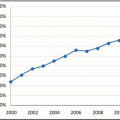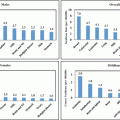© Springer International Publishing Switzerland 2016
Michael Silbermann (ed.)Cancer Care in Countries and Societies in Transition10.1007/978-3-319-22912-6_2626. University of Texas MD Anderson Cancer Center Experience Caring for Patients from Countries Undergoing Political–Social Conflict
(1)
Department of Palliative Care and Rehabilitation Medicine, University of Texas MD Anderson Cancer Center, 1400 Pressler Street, Unit 1414, Houston, TX 77030, USA
(2)
Department of Gynecological Oncology and Reproductive Medicine, University of Texas MD Anderson Cancer Center, 1515 Holcombe Blvd., Unit 1362, Houston, TX 77030, USA
Keywords
ImmigrantsPreventionCancer early detectionUterine cervical cancerBreast cancerCancer screeningColposcopyBrief Overview of the Current Status of Cancer Care in the USA
Cancer car e in the USA is highly technologically advanced. Personalized cancer care using molecular diagnostics to guide therapy is now the standard for patients with hematological malignancies, such as lymphoma and leukemia, as well as cancers originating in the breast, lung, colon, and other sites [1]. Personalized, high-tech medicine is expensive. US citizens spend far more per capita on medical technology, such as expensive imaging techniques and intensive care, than citizens of any other country [2]. The USA spends over 17 % of its gross domestic product (GDP) on health care, as compared to other countries in the Organization for Economic Development and Cooperation (OEDC), which spend approximately 8–9 % GDP [3]. Despite spending more, Americans have a life expectancy that is approximately 4 years less than that of citizens of other developed nations [4]. The US cancer burden is projected to increase substantially in future years due to the burgeoning older population, infectious diseases that transmit cancer-causing viruses and other pathogens, and an obesity epidemic. For instance, the population of Texas, the state in which MD Anderson Cancer Center is located, is projected to increase to 29 million in 2030 and to 32 million by 2040 (Texas Data Center and Office of the State Demographer, 2012, Migration Scenario for 2010–2050 in 1-year increments). Texans 65 or older likely will make up 21 % of the state’s population by 2050, compared to 12 % in 2014 (Texas Data Center and Office of the State Demographer, 2012. Age, Sex, and Race/Ethnicity Population by Migration Scenario).
Personalized cancer care is much more than just molecular and high-tech medicine. Another important aspect of personalized cancer care is palliative and supportive care integrated throughout the illness trajectory, especially as end-of-life approaches. Cancer care near the end of life should be person centered, family oriented, and evidence based. Education of US health professionals who provide care to people nearing the end of life has improved substantially in the past two decades, and the clinical fields of hospice and palliative care have become more established. Nonetheless, the number of specialists in these fields is too small, and too few clinicians in primary and specialty fields that entail caring for individuals with advanced serious illnesses are proficient in basic palliative care. Availability of palliative care services has not kept pace with the growing demand. Clinicians are often reluctant to have honest and direct conversations with patients and families about end-of-life issues. Patients and families face additional difficulties presented by the health care system itself, which does not provide adequate financial or organizational support for the kinds of health care and social services that might truly make a difference to them [5].
In addition, significant disparities exist in the US health care, since many Americans are either uninsured or underinsured. The Affordable Care Act (ACA) was passed by congress and signed by President Obama in March 2010 with the intention of reducing health disparities and ultimately making health care more affordable. However, the ACA remains politically charged, and debate continues regarding how best to reform the American health care system to optimize clinical outcomes and cost-effectiveness [6].
Populations in Transition
Many undocumented immigrants who are neither citizens nor permanent residents seek health care in the USA. The vast majority of these immigrants come from Latin America, primarily Mexico and the northern triangle of Central America, namely El Salvador, Honduras, and Guatemala. Many are unaccompanied minors. Drug violence, lack of economic opportunity, and poor access to health care have driven massive Latin American migration in recent years. In addition, the worldwide economic recession of 2008 caused many US residents, both citizens and noncitizens of all ethnic backgrounds, to lose private health insurance and seek care in safety net systems. An estimated 5.7 million Texans—22.5 % of the state’s population—lack health insurance, the highest percentage of uninsured citizens in the country (U.S. Census Bureau, 2012 American Community Survey). An estimated 17.9 % of Texans have incomes below the federal poverty level (U.S. Census Bureau, Small Area Income and Poverty Estimates, 2012). Indigent patients are much less likely to seek preventive services. Economic hardship and the recent wave of immigration from Latin America have therefore resulted in a much higher incidence of preventable cancers, such as cervical cancer, and a shift toward higher stage cancers.
MD Anderson Cancer Center Affiliation with Harris Health System to Address Health Disparities Resulting from Migration Shifts and Economic Hardship
MD Anderson Cancer Center is closely affiliated with the Lyndon Baines Johnson (LBJ) hospital, which is a major component of the Harris Health system, the safety net for indigent patients in Harris County, Texas. LBJ is one of the busiest county hospitals in the nation serving one of the largest uninsured populations. LBJ and other Harris Health system facilities serve anyone who can prove they reside in Harris County, but not all such residents are US citizens or permanent US residents. Several are undocumented immigrants, primarily originating from Latin America and to a lesser extent Far East Asia and other countries. However, it is impossible to determine the country of origin or immigration status of LBJ patients. Regardless of this uncertainty, Harris Health System clearly serves many patients who were displaced from other countries by economic hardship and violence.
Since 1995, MD Anderson faculty and fellows have provided innovative and multidisciplinary cancer care for thousands of patients at LBJ Hospital at no expense to Harris County. The service started 20 years ago as one part-time medical oncologist working one day a week. In FY13, MD Anderson funded 11 clinical faculty members, 18 medical oncology fellows, and five research nurses and mid-level providers to staff oncology services at LBJ, without cost to Harris Health. MD Anderson faculty and staff at LBJ provided care for 952 new patients and 9747 follow-up patient visits. The estimated annual value of professional services provided by faculty and staff is $3.6 million. In addition to the medical oncology clinic, MD Anderson faculty and staff run busy gynecologic oncology and urologic oncology clinics. Every day of the week, MD Anderson faculty, physicians in training, and staff care for outpatients make hospital rounds and perform surgery and outpatient procedures at LBJ. Patients at LBJ may also participate in several clinical trials approved by MD Anderson’s Institutional Review Board.
MD Anderson faculty members helped lead pivotal gynecological oncology clinical trials and enrolled many patients from the Harris Health System into those trials. Examples include Radiation Therapy Oncology Group (RTOG) 90-01, Gynecological Oncology Group (GOG) 204, and GOG 240. (RTOG) 90-01 was a randomized trial that showed that addition of fluorouracil and cisplatin to radiotherapy as compared to radiotherapy alone significantly improved survival of women with locally advanced cervical cancer without increasing the rate of late treatment-related side effects [7]. GOG 204 was a randomized trial for metastatic and recurrent cervical cancer that compared four cisplatin-based doublets containing paclitaxel, topotecan, vinorelbine, or gemcitabine [8]. GOG 240 was a randomized clinical trial that showed that addition of bevacizumab to combination chemotherapy in patients with recurrent, persistent, or metastatic cervical cancer was associated with an improvement of 3.7 months in median overall survival [9]. MDACC faculty members have helped establish standards of care for cervical treatment by contributing significantly to these pivotal trials. In doing so, they also provided state-of-the-art cancer care to many underserved patients, many of whom were immigrants from Latin America and other regions in conflict who otherwise would not have had access to care.
Stay updated, free articles. Join our Telegram channel

Full access? Get Clinical Tree





